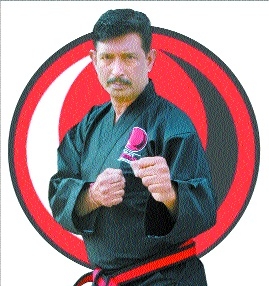Kumite is one of three main sections of karate: Choube
| Date :08-Jun-2021 |

Sports Reporter :
KUMITE, along with kata and kihon, is one of the three main sections of karate training, informed Kyoshi Harish Choube during a webinar on Monday. Choube was interacting with participants in the online seminar titled ‘Karate and Sports Seminar for Physical and Spiritual Development of the Students’. The sessions are being organised by Karate Budokan International (Vidarbha Region). Choube, Black Belt 7th Dan, National Chief Instructor and Examiner Karate Budokan International and National Sports Co-ordinator In the 53rd session of the series, Choube talked in detail about importance of kumite in karate. “Kumite is one of the three main sections of karate training along with kata and kihon. Kumite is part of karate in which a person trains against an adversary using the techniques learned from kihon and kata. Kumite can be used to develop a particular technique or a skill (effectively judging and adjusting one’s distance from the opponent) or it can be done in competition. “In some forms of competition kumite, punching (tsuki) and kicking (geri) techniques are allowed at the head (jodan) and abdomen (chudan). In some tournaments, face contact is allowed, sometimes limited to senior practitioners. Kumite is an essential part of karate training and free sparring is often experienced as exciting, because both opponents have to react and adapt to each other very quickly,” he said.
On the set up for a tournament, Choube said, “In tournaments kumite often takes place inside of a ringed area similar to that of a boxing ring. If karatekas step out of the ring, they are given a warning. If they step out of the ring two times, the other person gains a point. Many international tournaments use a point sparring form of kumite that requires control (pulling punches) and therefore warnings can be dealt for excessive force on techniques to the head, or sensitive areas. Full contact is permitted to the torso area of the body only. Some tournament rules allow for light contact to the head, whereas other rules do not allow this. The first competitor to take eight points in three minutes wins the bout.” Kumite is a safe sport if the guidelines laid down for a fight are followed correctly. “Kumite also includes a series of guidelines that, if followed correctly, result in a clean and safe fight. These are some of those guidelines: A karateka must remain in some form of proper fighting stance and in the kamae-te position (hands up, ready to fight position). A karateka must be aware of all obstacles around him/her. Karatekas must never deliberately endanger themselves by turning their back to their opponent,” Choube said. Players must concentrate on stance and footwork.
“A practised and well-trained karateka must concentrate on stance and footwork. It is often taught that a karateka who wishes to be fast and agile while competing in kumite should always be pulsing. Pulsing is where the karateka remains almost bouncing on their feet to maintain minimal frictional contact with the ground, allowing them to move quickly. Another aspect of kumite which is often seen in international tournaments, as well as many local competitions is what is referred to as clashing is where both opponents throw techniques against each other at the same time, often resulting in both getting hit with the techniques. This creates a problem for referees as they are unable to make out which technique was quick, on target and recoiled — all the things that constitute a clean technique that is scored. Because of clashing, most modern day karateka are taught to practice kumite in a one for one situation where one attacks, then the other attacks and so on. However, due to the speed of these techniques, and the speed of the footwork of each karateka, to the casual observer it may appear that they are still clashing when in fact they are not. When opponents are considered to be clashing, the head referee should declare aiuchi which means simultaneous hit. When a winner is decided, the referee will announce no kachi; which means win,” Choube explained in detail.
On the point system in kumite, Choube said, “National and international competition under the World Karate Federation includes the following point scoring: Yuko A – One Point – Straight Punch to the body; Yuko B – One Point – Straight Punch to the face; Wazari – Two Points – Middle Kick to the body; Ippon A – Three Points – Hook Kick to the head; Ippon B -Three Points – Punch to the body when the opponent has been taken to the ground.” The programme concluded with a session of questions and answers. Renshi Karunkumar Tirpude of Karate Budokan International proposed a vote of thanks.